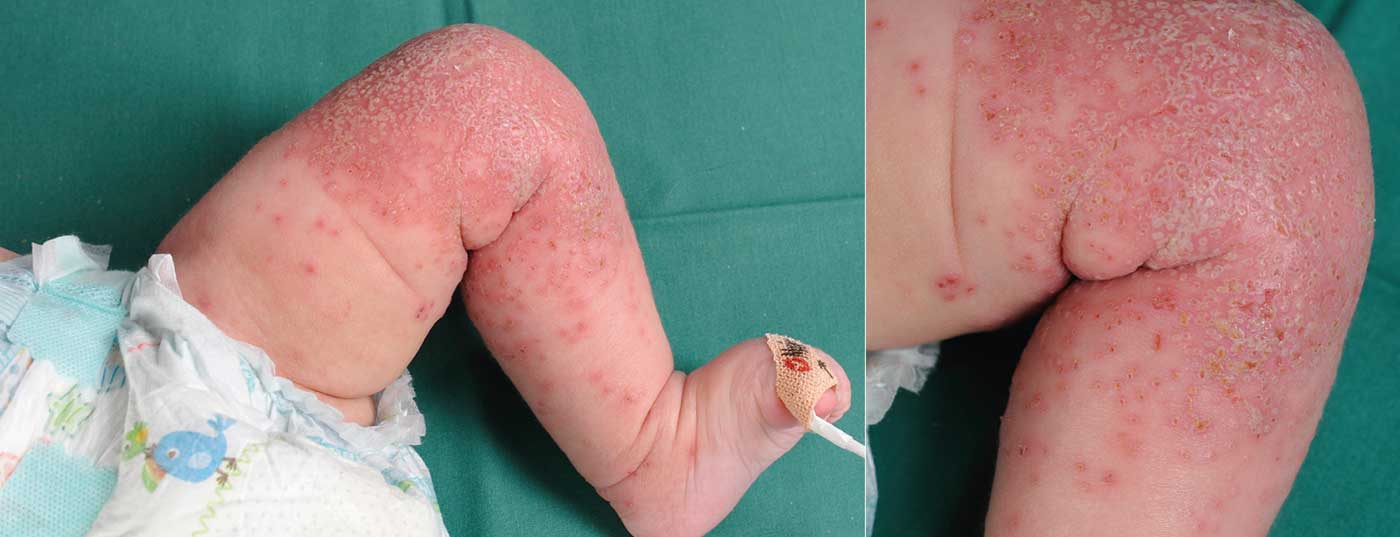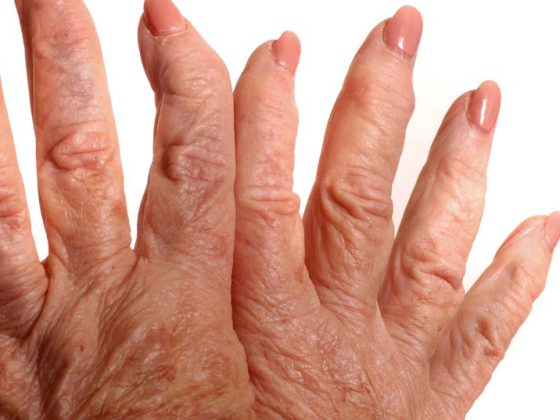Distinct exanthem disorders occur, especially in childhood, and their etiology is unknown. The most common cause of exanthema is viral infections. The focus is on herpes viruses, enteroviruses and parvovirus B 19.
Viral exanthemas are characterized by monomorphic efflorescences and can show the whole range of variation from macular, maculopapular, vesicular, papulovesicular, pustular, vesicopustular to urticarial. Distinct exanthem disorders occur, especially in childhood, and their etiology is unknown. The most common cause of exanthema is viral infections, which will be discussed in more detail below. The focus will be on herpes viruses, enteroviruses and parvovirus B 19. The classic viral diseases measles and rubella are not explained in this article.
Herpes simplex virus infections (HSV)
Herpes simplex virus infections in the neonatal period are fortunately rare. This includes both diaplacental infection, or infection transmitted during birth, and infection acquired postnatally through an infected contact. Mortality from neonatal disseminated HSV infection has decreased from 89% to 29% over the past 30 years due to improved diagnosis and therapy. Connatal and neonatal HSV infections are most commonly due to HSV2 [1].
Congenital herpes simplex infection is characterized by vesicular exanthema, erosions and scarring, and mucosal involvement. General condition is significantly impaired by nonspecific symptoms such as vomiting, apnea, cyanosis, and respiratory insufficiency. The diagnosis is made clinically and with positive Tzanck test. HSV DNA detection by PCR is used for verification.
Of central importance is the early administration of acyclovir intravenously over three weeks. Pregnant women with primary genital HSV infection should be treated with acyclovir. If the infection occurs after the 34th week of gestation, sectio is indicated [1].
Eczema herpeticatum
Eczema herpeticatum is a feared complication of atopic eczema caused by disseminated large-scale herpes simplex infection. Patients with severe and untreated atopic eczema get sick more often. Children show disseminated or generalized seeding of monomorphic, single-chambered vesicles (Fig. 1) that develop into ephemeral pustules. After their bursting, erosions occur.
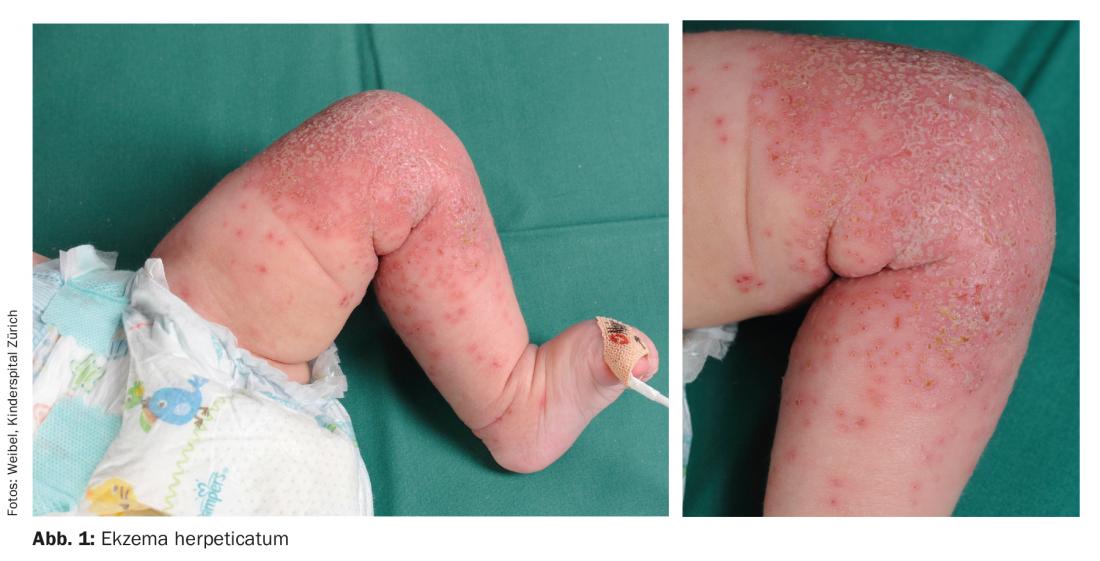
Patients feel sick, have high fever and headache. Diagnosis is made by cultural cultivation of the virus from the vesicle contents and by PCR. The most feared complication of eczema herpeticatum is generalized invasive HSV infection with multiorgan involvement, meningoencephalitis, and a mortality rate of 1-9%. If eczema herpeticatum is suspected, systemic acyclovir therapy must be started immediately. Dehydrating measures and antiseptic topicals are also recommended.
Varicella
Intrauterine infection with varicella zoster virus (VZV) is rare, with only 5-7% of pregnant women being seronegative. Varicella infection of pregnant women in the first five months of pregnancy leads to varicella syndrome in 2% of children. Varicella in the first 10-12 days of life has a variable prognosis depending on the timing. Varicella disease in pregnant women five days before to two days after delivery results in severe disease in the child due to lack of maternal antibodies [1].
Fetal varicella syndrome is characterized mainly by cutaneous scars and defects of the eyes, nervous and skeletal systems. Vesicles and pustules on a reddened base in a generalized distribution are consistent with neonatal varicella; efflorescences are monomorphic in contrast to varicella later in life. Hepatitis, respiratory insufficiency, and encephalitis may occur as complications.
Diagnosis is by serology and DNA detection by PCR from vesicle contents. Treatment is with acyclovir intravenously. Prophylactically, varicella-zoster immunoglobulin is administered postnatally to newborns whose mothers become ill five days before to two days after delivery [1].
Varicella is most commonly found in 5-9 year old children. Transmission is by droplet or smear infection. After an incubation period of 14-21 days, children develop exanthema in combination with fatigue and fever (Fig. 2).
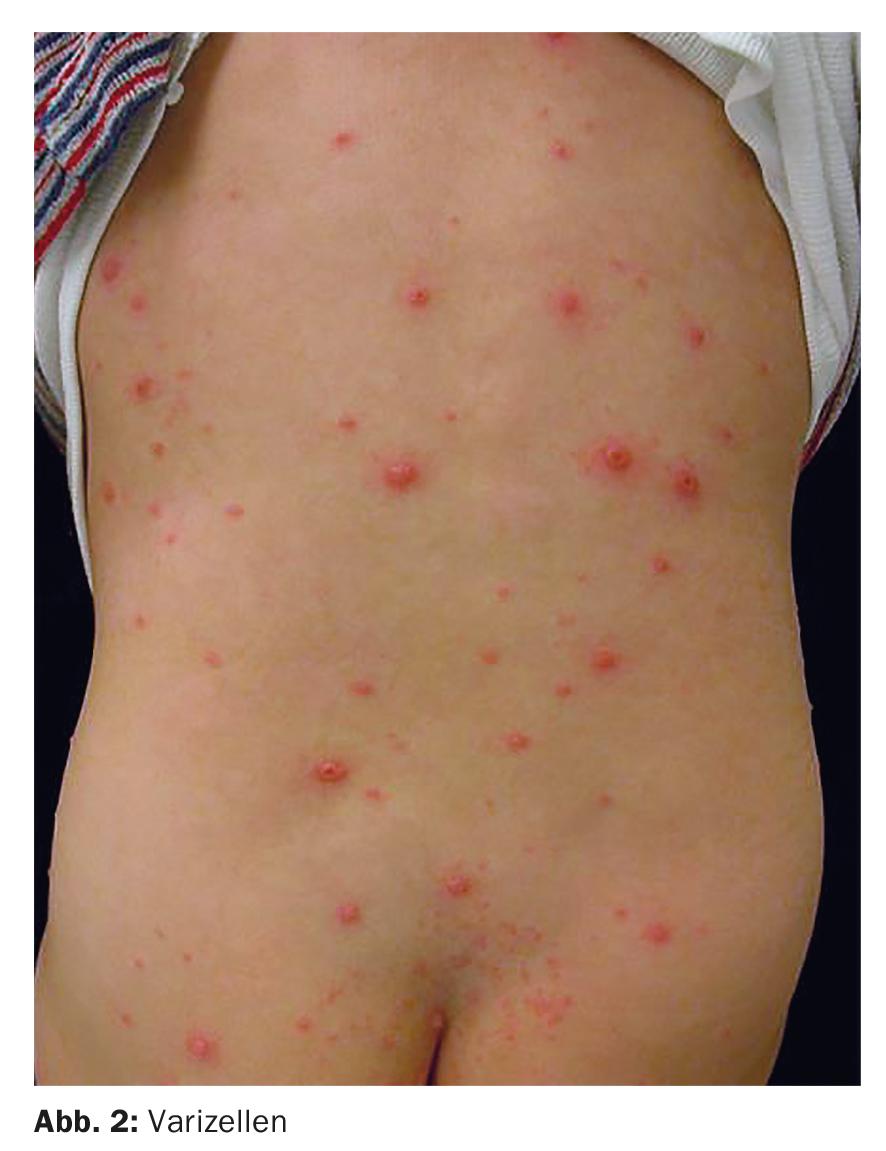
As a rule, the infection runs without complications. Contagiousness is very high and persists from three days before to seven days after the onset of exanthema. The vesicles are followed by the pustule and crust stages with the typical appearance of different stages, which leads to the colorful picture of the Heubner star chart. In unclear cases, VZV DNA detection by PCR can be performed.
Antihistamines can be used against itching, local therapy is performed with white shake mixture 1-2× daily. Passive immunization with VZV immunoglobulins is reserved for immunocompromised individuals and should preferably be given three days after contact [1].
Patients with atopic eczema may have a more severe course of varicella, which is why varicella vaccination is recommended from the age of 12 months.
Childhood herpes zoster
Reactivation of VZV can manifest as herpes zoster and can also occur in infancy and early childhood. Maculo-papular lesions form along one or more dermatomes, which turn into vesicles and become crusted as they progress. Normally, cutaneous manifestations resolve within 2-3 weeks (Fig. 3). As a rule, systemic therapy is not required in children, with the exception of immunosuppressed children and problem localizations in the facial region. Depending on the situation, valaciclovir can be used perorally or, alternatively, acyclovir can be used intravenously.
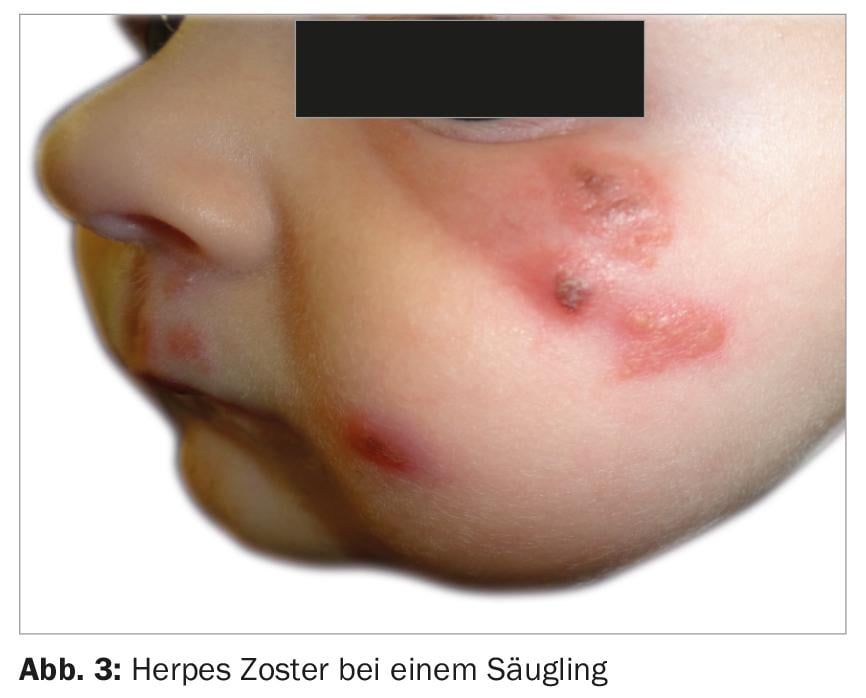
Pityriasis rosea
Pityriasis rosea rarely occurs before the age of 10. Boys and girls are affected equally often. The cause of pityriasis rosea has not been definitively determined, but an association with group 6 and 7 herpesviruses is suspected. It is assumed that pityriasis rosea is an expression of reactivation of a latent infection with the aforementioned herpesviruses.
Exanthema may be preceded by a prodromal stage with respiratory and gastrointestinal symptoms. Typical is the appearance of a mother plaque, characterized by an oval red-brownish lesion with collerette-like scaling. 2-4 days later, smaller oval scaly plaques resembling the mother plaque appear in the skin cleavage lines. Extreme skin sensitivity to irritants explains the pruritus reported by one subgroup. An atypical distribution is found in pityriasis rosea inversa; the collerettiform scaling plaques are found predominantly in the intertrigines. In dark-skinned individuals, facial involvement is more common.
Endogenous reactivation of HHV6 in pregnancy has been reported to increase the risk of preterm delivery and miscarriage by 18% [3]. Manifestation within the first 15 weeks of pregnancy poses the greatest risk of intrauterine death for the fetus [4].
Pityriasis rosea is a self-limiting skin disease. Various studies investigated the efficacy of antibiotics, antivirals and UV light. Acylovir (off label) has also been shown to be effective in isolated cases. Erythromycin may shorten the course of the disease if necessary.
Hand, foot and mouth disease
Hand-foot-mouth disease (HFMD) is most commonly caused by two RNA viruses of the enterovirus A group: HFMD mainly affects children aged 0-4 years. Kindergartens provide the best conditions for fecal-oral, oral-oral, or respiratory transmission, so outbreaks are not uncommon, especially in the summer and fall months. After an incubation period of 3-7 days, HFMK classically manifests with fever, malaise, papules, vesicles, and erosions on the palms, soles, distal extremities, and buttocks, as well as aphthae on the buccal and pharyngeal mucosa (Fig. 4).
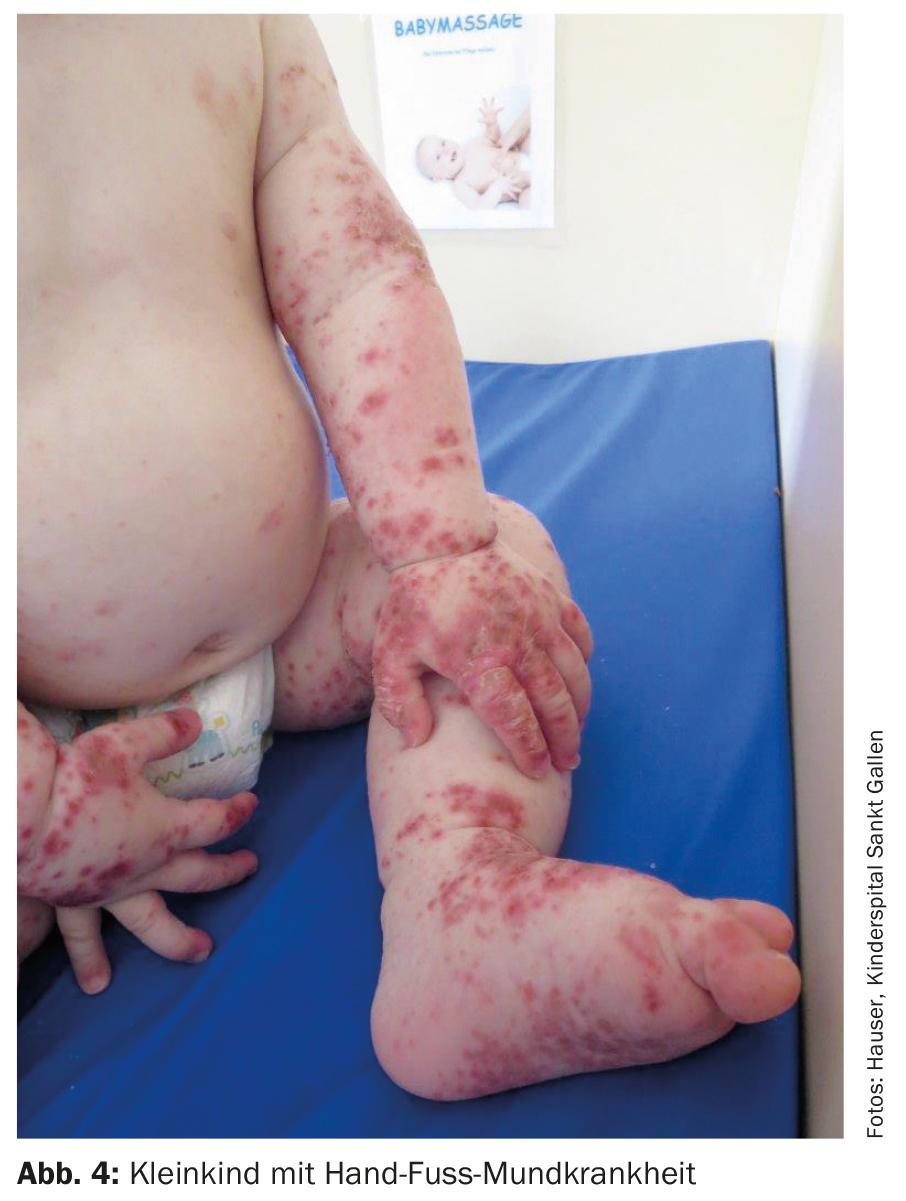
In immunocompetent children, the disease takes a benign course and heals within 7-10 days.
In recent years, much more severe disease manifestations have been reported worldwide, primarily in the context of outbreaks caused by the virulent coxsackie virus A6. By analogy with eczema herpeticatum, these cases are called eczema coxsackium. The duration of illness extends to about 12 days in the severe cases, thus is much longer than in classical HFMK. Late effects are desquamation of the palms and soles of the feet and the well-known onychomadesis. Differential diagnosis must include impetigo contagiosa, eczema herpeticatum, vasculitis, or bullous autoimmune dermatosis [5].
Erythema infectiosum ringworm
The infection is seasonally clustered in the winter and spring months and mainly affects school-age girls. The viruses are most often transmitted by droplets. The incubation period is 4-14 days. Contagious children are only before the appearance of the exanthema. The diaplanzentar transmission probability is about 10%. Especially in the 2nd trimester, hydrops fetalis may occur due to concomitant anemia. Erythema infectiosum is caused by parvovirus B19, whose target is erythroblasts.
Only 15-20% of parvovirus B-19 infected individuals develop the exanthema. A homogeneous, strong reddening of the cheeks (“slapped cheeks”) is typical, followed three days later by erythema on the proximal extremities in a typical garland-shaped or reticular arrangement (Fig. 5). The course is characterized by constant fading and reflorescence of the efflorescences.
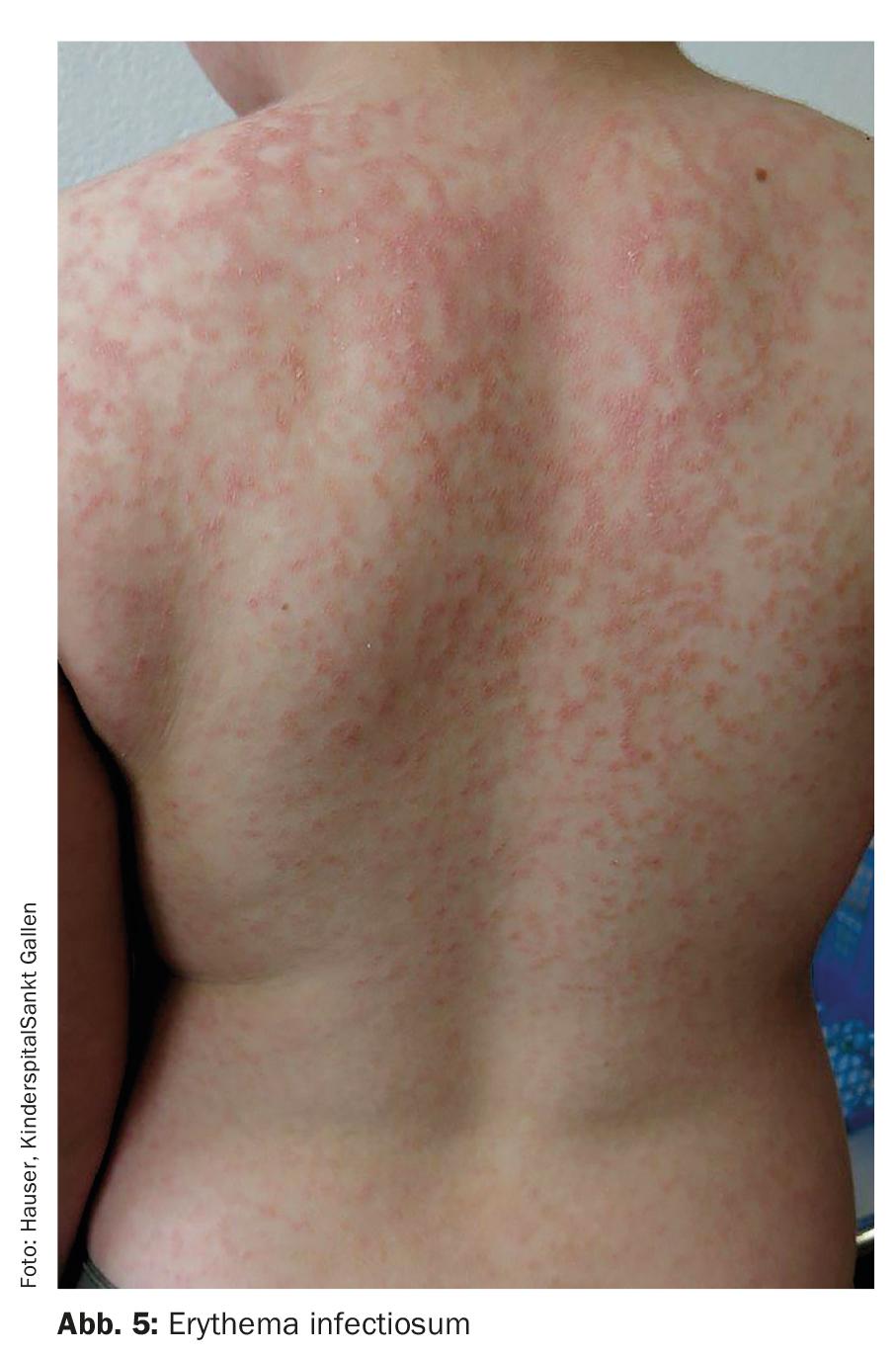
Enzyme immunoassays and immunofluorescence tests for the detection of IgM and IgG antibodies are available to confirm the diagnosis. For infections during pregnancy, arrange weekly ultrasound checks.
Erythema infectiosum is self-limiting and usually does not require therapy. In cases of hydrops fetalis and verified infection, repeated intrauterine red blood cell transfusions are the treatment of choice. In chronic parvovirus B-19 infection and in immunocompromised patients, administration of immunoglobulins for 5-10 days has been shown to be effective [5].
Literature:
- Fölster-Holst R: Viral exanthema, Der Hautarzt 2004; 55: 804-817.
- Kempf W, et al: Genital herpes and herpes zoster, Switzerland Med Forum 2002; 14: 323-330.
- Browning JC: Pityriasis Rosea and PR-like Mimics – What to Know and When to Worry. Lecture. 13th World Congress of Pediatric Dematology Chicago: July 8, 2017 (own transcript).
- Fölster-Holst R: Paraviral exanthema, Der Hautarzt 2017; 68: 211-216.
- Hamm H: Hot Topic: Pediatric Dermatology. Lecture. Derma update Wiesbaden: November 12, 2016 (own transcript).
DERMATOLOGIE PRAXIS 2017; 27(4): 25-28


